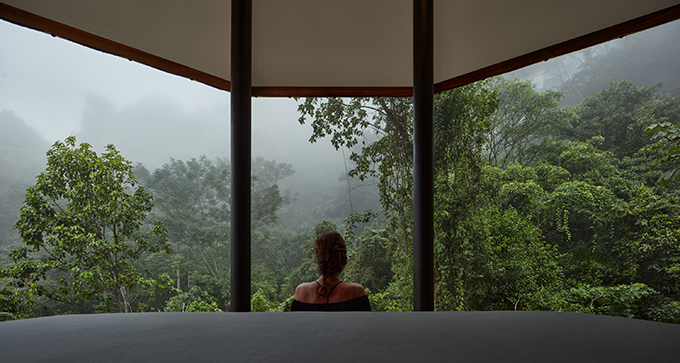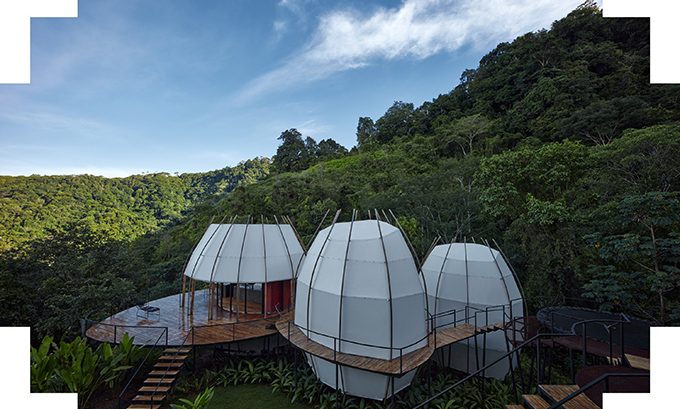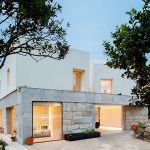
ARCHWERK studio teamed up with Formafatal for the design of COCO – five egg shaped structures houses that form a part of the Art Villas Resort in Costa Rica, representing a unique example of playful, glamping, sustainable and modern tropical architecture hidden in the lush jungle. Take a look at the complete story after the jump.

Above Hermosa Beach, near the Costa Rican town Uvita, on a steep 2.5-hectare tropical jungle slope – there is hidden Art Villas resort.
COCO forms a part of the complex and represents a unique example of playful, glamping, sustainable and modern tropical architecture.
When the investor approached the architects, he desired to create a place where the visitors merge with the surrounding nature, clear their mind and experience luxury and adventure at the same time.
He wanted to create a place that digs deep into everyone´s heart.

Architect’s note – ARCHWERK
Filip turned to us with an amazing challenge: to build with simple solutions and local materials a luxurious, but at the same time adventurous living, bringing the experience of an immediate stay in the Costa Rican jungle. According to his words, they should be “tree houses” placed on the hillside of the Art Villas resort, but in the freshly established garden without fully grown trees. And he asked for a design that no one had seen before. We designed a nest of several shelters located on a fall overlooking the valley and named them Coco.
In our design, we used our previous experience from the completion of our experimental design and build projects on the border of architecture, landscape architecture and urban design. The main construction material is local tropical wood, complemented by a tent canvas and metal elements. Rational construction is the basis of the design. It creates the form and atmosphere by itself, without needing of any added decoration. The construction principle allows flexibility in the size, shape and composition of several similar objects in complicated terrain. “The same creative principle is used by Nature for millions of years. The Nature inspires us to create an environment that we love and feel safe in. We follow on from to the principles of Natural Architecture, as formulated by our friend and teacher, architect Martin Rajniš”, says Martin Kloda.


Architect’s note – Formafatal
Studio Formafatal followed up on the work of architects from Archwerk and, together with client Filip Žák, finished the layout of individual Coco buildings on the plot. A set of five small buildings levitates a few meters above the sloping terrain and is absorbed by lush tropical vegetation.
Studio Formafatal has sensitively connected the individual buildings by footbridges and stairs made of wood and expanded metal, which are mounted on steel columns. The platforms serve as stopping points for views of the countryside, or you can even jump on a trampoline on one of the landing.
The footbridges and landings have minimalist shape and we intentionally designed them in clean lines, which are typical for other buildings in the resort. Only the main terraces in the two height levels are based on the form of the Coco houses themselves, the shapes are soft and organic. These terraces are set very close to the jungle and also offer views of the Pacific Ocean.
The interiors are minimalist and playful. You will not find anything unnecessary there, but at the same time nothing is missing. The focal point of each Coco bedroom is a bed that sits on a raised part of the floor. The layout in each cabin is designed to take advantage of the most breathtaking views, where monkeys and toucans can be seen directly from the bed. The mosquito net is kind of object in the object respecting the shape of the building and is the dominant element of every bedroom. Back of the beds are designed from the welded wire mesh. In each bedroom, a different color is chosen, which is further reflected in the color scheme of the dressing rooms. The artistic design for the woven headboards is not accidental. “When I thought about a motif that would fit into Coco, it evoked in me the canopy tours, which are very popular in Costa Rica. These are trails and zip lines high above the ground in the treetops and Coco are also scattered a few meters above the ground. That’s why I used the motif of a climbing rope in the form of straps and colored cords, which also brings a color accent to Coco interiors”, says Dagmar Št?pánová.
In the largest Coco there is a shared kitchen with dining area. The red cabinet wall in the color of “mamón chinos (tropical fruit)” contains 2 refrigerators, 2 freezers and food cabinets. The kitchen island serves for meal preparation and offers plenty of storage space for all dishes. The dining table is a visual continuation of the island, as if it just tore off. This longitudinal axis is the intention and aims at a view of the Pacific Ocean. The rest of the interior of the Coco kitchen is equipped with wicker furniture and lighting of local production.

Studio ARCHWERK [concept and architectural design] – www.archwerk.cz
Formafatal [interior design, exterior finishing] – www.formafatal.cz
Author Martin Kloda [ARCHWERK]
Hana Procházková [ARCHWERK]
Dagmar Št?pánová [Formafatal]
Project location Bahia Ballena, Playa Hermosa
Project country Costa Rica
Project year 2018-2019
Completion year June 2020
Usable Floor Area interiors area: 140 m2
terraces area: 204 m2
Plot size 25000 m2
Client Filip Žák
Photography by BoysPlayNice – Jakub Skokan and Martin T?ma.
Collaborator Landscape architect – greenery and garden elements: atelier Flera



